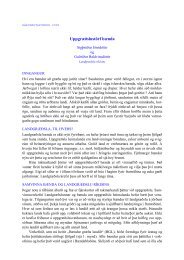Factors involved in ice nucleation and propagation ... - Landbunadur.is
Factors involved in ice nucleation and propagation ... - Landbunadur.is
Factors involved in ice nucleation and propagation ... - Landbunadur.is
Create successful ePaper yourself
Turn your PDF publications into a flip-book with our unique Google optimized e-Paper software.
ICE NUCLEATION AND PROPAGATION IN PLANTS 45<br />
cools back down to ambient temperatures. In<br />
the second stage, which can often be d<strong>is</strong>t<strong>in</strong>ctly<br />
separated from the first step, the extracellular<br />
<strong>ice</strong> <strong>in</strong>duces a much more substantial freez<strong>in</strong>g<br />
event where bulk water <strong>in</strong> the xylem conduct<strong>in</strong>g<br />
elements freezes, water <strong>is</strong> drawn out of<br />
cells <strong>and</strong> freezes extracellularly. Th<strong>is</strong> <strong>is</strong> seen<br />
as a substantial exothermic event that pers<strong>is</strong>ts<br />
for an extended period of time. Th<strong>is</strong> second<br />
freez<strong>in</strong>g event <strong>is</strong> easily propagated throughout<br />
the rest of the plant. Ice does not, however,<br />
move down through a stem <strong>in</strong>to a below-ground<br />
portion of a plant <strong>and</strong> then back<br />
up <strong>in</strong>to another above-ground portion of a plant.<br />
For example, <strong>ice</strong> does not propagate down a<br />
potato stem <strong>in</strong>to a tuber <strong>and</strong> then back up an-<br />
Figure 3. Infrared image of tomato (Lycopersicon<br />
esculentum) leaves. Leaf on right has been coated<br />
with a hydrophobic particle film. The leaf on the<br />
left had frozen at approx. –2.3°C <strong>and</strong> <strong>is</strong> warmer<br />
than ambient due to the heat given off by the<br />
freez<strong>in</strong>g process. The leaf on the right <strong>is</strong> unfrozen<br />
at –3.8°C despite the presence of a frozen droplet<br />
of INA bacteria (round dot) on its surface. Th<strong>is</strong><br />
<strong>in</strong>dicates that hydrophobic films may represent a<br />
method of frost protection.<br />
3. mynd. Innrauð mynd af tómatlaufblaði (Lycopersicon<br />
esculentum). Blaðið til hægri hefur verið þakið<br />
með vatnsfæl<strong>in</strong>ni húð. Laufblaðið til v<strong>in</strong>stri hefur<br />
verið frosið til –2,3°C og er heitara en umhverfið<br />
vegna hitagjafar við fryst<strong>in</strong>guna. Blaðið til hægri<br />
er ófrosið við –3,8°C, þrátt fyrir fros<strong>in</strong>n dropa<br />
með ískr<strong>is</strong>tallamynd<strong>and</strong>i bakteríu (kr<strong>in</strong>glóttur<br />
punktur) á yfirborð<strong>in</strong>u. Þetta sýnir að vatnsfæl<strong>in</strong><br />
himna getur verndað gegn frosti.<br />
other stem (Fuller <strong>and</strong> W<strong>is</strong>niewski, 1998). If<br />
<strong>ice</strong> formation occurs at a warm temperature,<br />
appendages attached to the organ that <strong>in</strong>itially<br />
froze may escape freez<strong>in</strong>g for a period of time,<br />
<strong>in</strong>dicat<strong>in</strong>g that some barriers to <strong>ice</strong> <strong>propagation</strong><br />
do ex<strong>is</strong>t. The two steps of the freez<strong>in</strong>g<br />
process become superimposed on each other<br />
if freez<strong>in</strong>g <strong>is</strong> <strong>in</strong>itiated after a significant amount<br />
of supercool<strong>in</strong>g has occurred.<br />
FREEZING OF WOODY STEMS AND<br />
BARRIERS TO ICE PROPAGATION<br />
As previously documented, the presence of<br />
effective, <strong>in</strong>tr<strong>in</strong>sic nucleators, appears to be<br />
common <strong>in</strong> woody plants. These nucleators<br />
appear to be as effective as external <strong>ice</strong> nucleators,<br />
such INA bacteria, <strong>and</strong> <strong>in</strong>duce the stems<br />
to freeze at warm, subzero temperatures. Barriers<br />
appear to ex<strong>is</strong>t, however, that prevent<br />
<strong>ice</strong> <strong>propagation</strong> <strong>in</strong>to lateral appendages such<br />
as buds, or newly extended primary t<strong>is</strong>sues<br />
(flowers, <strong>in</strong>florescences, etc.) (Carter et al.,<br />
1999; Workmaster, 1999). These barriers are<br />
most effective if the <strong>in</strong>itial freez<strong>in</strong>g event occurs<br />
at a relatively warm temperature. These<br />
barriers have been observed <strong>in</strong> the <strong>propagation</strong><br />
of <strong>ice</strong> <strong>in</strong>to the strigs of Ribes <strong>and</strong> grapev<strong>in</strong>es,<br />
the ped<strong>ice</strong>l of cranberry fruits, <strong>and</strong> flowers<br />
of peach <strong>in</strong>dicat<strong>in</strong>g that the ability of buds,<br />
flowers, <strong>and</strong> <strong>in</strong>florescences to supercool <strong>in</strong><br />
the presence of frozen stem material may be<br />
an active mechan<strong>is</strong>m of freeze avoidance.<br />
INFLUENCE OF COLD ACCLIMATION<br />
AND ANTIFREEZE PROTEINS ON ICE<br />
NUCLEATION<br />
When plants are cold acclimated, they develop<br />
a greater ability to supercool. Th<strong>is</strong> has<br />
been demonstrated <strong>in</strong> canola <strong>and</strong> barley, <strong>and</strong><br />
rye plants. When cellular extracts of canola<br />
were placed on filter d<strong>is</strong>cs, similar responses<br />
to those of <strong>in</strong>tact plants were made, <strong>in</strong>dicat<strong>in</strong>g<br />
that sugars <strong>and</strong> prote<strong>in</strong>s present <strong>in</strong> acclimated<br />
plants may play a role <strong>in</strong> enhanc<strong>in</strong>g<br />
supercool<strong>in</strong>g. Transgenic Arabidops<strong>is</strong> plants<br />
express<strong>in</strong>g an <strong>in</strong>sect antifreeze prote<strong>in</strong> also<br />
exhibited an enhanced ability to supercool (Tao
















